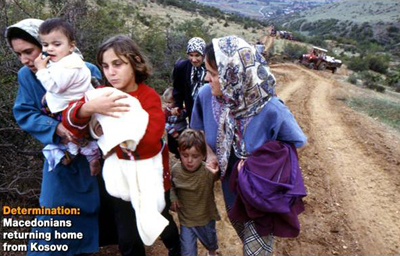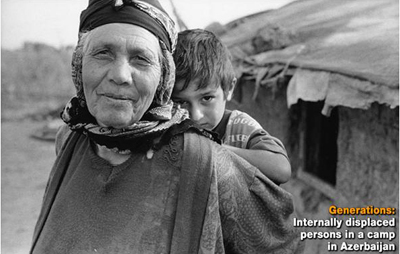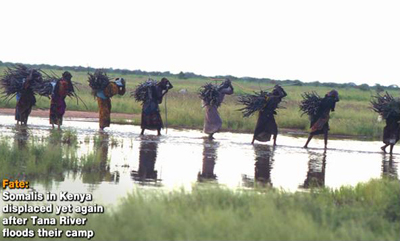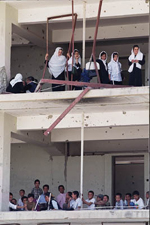Definitions
In this section
you will learn the definitions of key terms
and phrases used in the field of humanitarian relief.
What is a disaster?
A disaster is a calamitous event resulting in loss of life, great human suffering and distress, and large-scale material damage. (Source: The Sphere Project, 2004)
Disaster events can cause immediate injury and loss of life and are often equally as devastating to infrastructure, causing severe damage, particularly in developing countries.
Some types of disasters and recent examples of each:
Hurricanes - In 2005, Hurricane Katrina affected the lives of nearly six million people in the United States, with at least 1,800 mortalities.
Drought - In 2000, Ethiopia and Eritrea suffered their most severe drought since 1984. The countries continue to suffer from severe drought conditions, which have drastically increased the number of people relying on food aid.
Cyclone - In 2008, Myanmar was struck with cyclone Nargis, the deadliest cyclone in the North Indian Ocean Basin, killing more than 146,000 people.
Earthquakes - In 2005, a massive earthquake affected Afghanistan, India and Pakistan, with an epicenter in Pakistan-administered Kashmir. Estimates suggest that more than 74,500 were killed and at least 106,000 were injured. In 2008 an earthquake struck Sichuan Province in China, killing at least 69,000 people and leaving more than 20,000 homeless. The earthquake also caused significant structural damage to dams in the area.
Infectious Disease Outbreak - The cholera epidemic which broke out in August 2008 in Zimbabwe continues today having spread to over 98,000 cases and nearly 5,000 deaths.
Human-made disasters - This category of disaster can be interpreted broadly and used to encompass many different types of disasters. Train crashes, such as the one that killed over 200 people in Tanzania in June 2002 is one example of a human-made disaster. Long-term human-made disasters tend to refer to civil strife, civil war and international war and are described in more detail in the following section on "complex emergencies".
Public Health Impact of Selected Disasters
Effect |
Complex Emergencies |
Earthquakes |
High Winds |
Floods |
Flash floods/ tsunamis |
Deaths |
Many |
Many |
Few |
Few |
Many |
Severe injuries |
Varies |
Many |
Moderate |
Few |
Few |
Increased risk of communicable diseases |
High |
Small |
Small |
Varies |
Small |
Food Scarcity |
Common |
Rare |
Rare |
Varies |
Common |
Major population displacements |
Common |
Rare |
Rare |
Common |
Varies |
(Sphere, 2004)
What is a complex emergency?
A complex emergency is “a humanitarian crisis in a country, region or society where there is total or considerable breakdown of authority resulting from internal or external conflict and which requires an international response that goes beyond the mandate or capacity of any single agency and/ or the ongoing United Nations country programs.”
(Source: Burkle FM. Complex humanitarian emergencies: A review of epidemiological and response models. J Postgrad Med [serial online] 2006 [cited 2006 Jun 8];52:110-115.)
“Complex emergencies” are typically characterized by:
-extensive violence and loss of life, massive displacements of people, widespread damage to societies and economies;
-the need for large-scale, multi-faceted humanitarian assistance
-the hindrance or prevention of humanitarian assistance by political and military constraints, and
-significant security risks for humanitarian relief workers in some areas.
 |
Given the definition above, which of the following is an example of a complex emergency? |
|
 |
a. |
Darfur Genocide, 2007 |
|
 |
b. |
Hurricane Katrina, 2005 |
|
 |
c. |
Earthquake in Kashmir, Pakistan, 2005 |
| |
Examples of Complex Emergencies
Each of the following countries experienced violent events and continue to face the consequences of conflict.
For more information on each, please click on the country:
Rwanda - 1994
Kosovo – 1998/99
Afghanistan – 2001/ Present
DRC-2006/Present
Darfur – 2007/Present
Iraq – 2003/Present
Gaza 2008/2009
Pakistan 2009/present
What are the ‘Phases of a crisis’?
The emergency phase of a crisis is often defined as the period when crude mortality rates (# of deaths/10,000 population/per day) are at least 2 times higher than baseline. (Ref: Sphere, 2004, p 260)
The post-emergency phase begins when the basic needs of the population (food, water, shelter, health care etc...) have been met and the crude mortality rates are comparable to those of the surrounding population. This phase ends only when a permanent solution has been found for the refugee population through repatriation to their country of origin or integration into a host community.
The durable solution phase involves returning refugees to their communities in their country of origin (repatriation) or integrating refugees permanently into new communities in host countries or their country of origin (reintegration) or to a third country (resettlement).

(Source for “Phases of a crisis”: UNHCR)
What is Forced Migration?
Forced Migration is “a general term that refers to the movements of refugees and internally displaced people (those displaced by conflicts within their country of origin) as well as people displaced by natural or environmental disasters, chemical or nuclear disasters, famine, or development projects.”
There are many causes of displacement
Some of the more common include:
Conflict-Induced Displacement occurs when people are forced to flee their homes as a result of armed conflict including civil war, generalized violence, and persecution on the grounds of nationality, race, religion, political opinion or social group.
Development-Induced Displacement occurs when people are compelled to move as a result of policies and projects implemented to advance ‘development’ efforts. Examples of this include large-scale infrastructure projects such as dams, roads, ports, airports; urban clearance initiatives; mining and deforestation; and the introduction of conservation parks/reserves and biosphere projects.
Disaster-Induced Displacement occurs when people are displaced as a result of natural disasters (floods, volcanoes, landslides, earthquakes), environmental change (deforestation, desertification, land degradation, global warming) and human-made disasters (industrial accidents, radioactivity).
Forced migrant terms
Refugees - The legal definition of a refugee, which is enshrined in the 1951 United Nations Convention Relating to the Status of Refugees, defines a refugee as a person residing outside his or her country of nationality, who is unable or unwilling to return because of a ‘well-founded fear of persecution on account of race, religion, nationality, membership in a political social group, or political opinion’. Those recognized as refugees have a clear international legal status and are afforded the protection of the United Nations High Commissioner for Refugees (UNHCR).
Asylum seekers - Asylum seekers are people who have moved across international borders in search of protection under the 1951 Refugee Convention, but whose claim for refugee status has not yet been determined.
Internally Displaced Persons (IDPs) – The United Nations report, Guiding Principles on Internal Displacement uses the definition: ‘internally displaced persons are persons or groups of persons who have been forced or obliged to flee or to leave their homes or places of habitual residence, in particular as a result of or in order to avoid the effects of armed conflict, situations of generalized violence, violations of human rights or natural or human-made disasters, and who have not crossed an internationally recognized State border.

Development-induced displaced - This category includes people who are compelled to move as a result of policies and projects implemented to ‘enhance’ development. People displaced in this way are sometimes also referred to as ‘oustees’, ‘involuntarily displaced’ or ‘involuntarily resettled’.
Environmental and disaster-induced displaced - Sometimes referred to ‘environmental refugees’ or ‘disaster refugees’, most of those displaced by environmental factors or disasters do not leave the borders of their homeland. This category includes people displaced as a result of natural disasters (floods, volcanoes, landslides, earthquakes), environmental change (deforestation, desertification, land degradation, global warming) and human-made disasters (industrial accidents, radioactivity).

Smuggled people - Smuggled migrants are moved illegally for profit. Smuggled migrants may include those who have been forcibly displaced as well as those who have left their homeland in search of better economic and social opportunities.
Trafficked people - Trafficked people are those who are moved by deception or coercion for the purposes of exploitation. The profit in trafficking people comes not from their movement, but from the sale of their sexual services or labor in the country of destination.

continue to... International legal instruments that apply in situations of forced migration
 |









